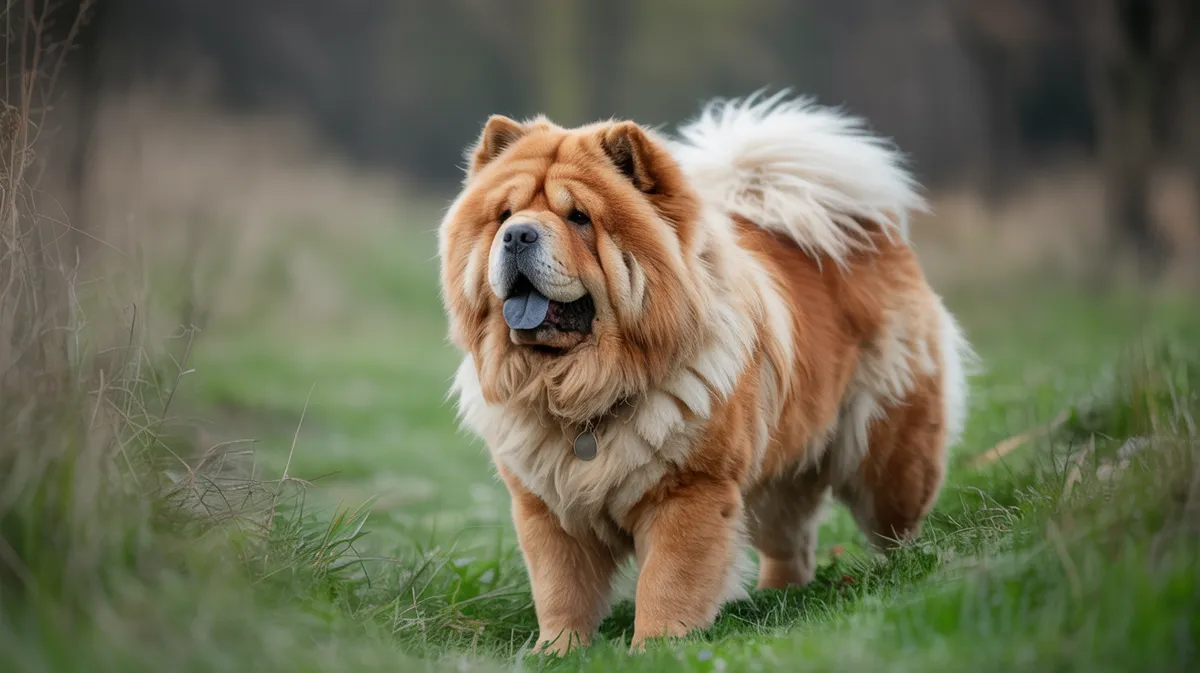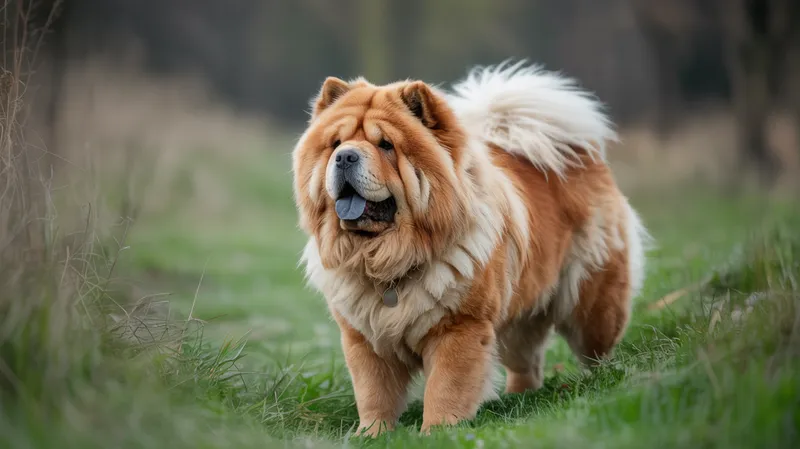
Chow Chow
Canis lupus familiaris

Meet the Chow Chow
The Chow Chow is a distinctive dog breed known for its lion-like mane, sturdy build, and deep-set almond eyes. This ancient breed originated in northern China and is recognized for its aloof yet loyal temperament. Chow Chows are easily identified by their thick double coat, which can be rough or smooth, and their unique blue-black tongue—a rarity among dog breeds. Renowned for their independence and regal demeanor, they require consistent training and socialization. Their dignified appearance and protective instincts make them valued companions and guardians.
Classification
Mammal
Habitat
Domestic
Diet
Omnivore
Lifespan
9-15 years
Conservation
Least Concern
Weight
20-32 kg (44-70 lbs)
📖Fascinating Facts
Blue-Black Tongue
Chow Chows are famous for their blue-black tongues, a rare feature among dog breeds, which they share with only a few other animals like the Chinese Shar-Pei.
Ancient Origins
This breed dates back over 2,000 years in China, where it was cherished by emperors and nobility for its guarding abilities, hunting skills, and even as a source of fur.
Lion-Like Mane
Their thick ruff of fur around the neck and shoulders gives them a distinctive lion-like appearance, further highlighting their dignified and imposing nature.
📋Detailed Description
The Chow Chow is a medium to large spitz-type dog breed, typically weighing between 35 and 85 pounds (16–39 kg) and standing 17 to 22 inches (43–56 cm) at the shoulder. Its most distinctive anatomical features include a broad, flat skull, deep-set almond-shaped eyes that give a scowling expression, and small, triangular, erect ears with rounded tips. The breed is renowned for its extremely dense double coat, which can be either rough or smooth, with a pronounced ruff around the neck reminiscent of a lion's mane. The coat comes in several solid colors, including red (ranging from light gold to deep mahogany), cinnamon, black, blue, and cream. One of the Chow Chow’s most unique adaptations is its blue-black tongue, a trait shared with only a few other breeds, such as the Shar Pei. The breed’s tail is set high and carried curled over the back. Chow Chows are known for their sturdy, square build and straight, stilted gait, which is a result of their relatively straight hind legs. Behaviorally, they are reserved, dignified, and often aloof with strangers, but deeply loyal to their families. Social structure within the household is important, as they tend to form strong bonds with one or two primary caregivers. Reproductively, Chow Chows have a typical litter size of 4–7 puppies, with a gestation period of approximately 63 days. The breed is relatively long-lived for its size, with an average lifespan of around 12 years. Their thick coat and robust constitution are evolutionary adaptations to the harsh, cold climates of northern China, where the breed originated.
💡 Did you know?
The ancient Chinese used Chow Chows as temple guards, hunting dogs, and even sled pullers—showcasing their versatility and strength.
🔬Research & Sources
Wikipedia Summary
The Chow Chow is a spitz-type of dog breed originally from Northern China. The Chow Chow is a sturdily built dog, square in profile, with a broad skull and small, triangular, erect ears with rounded tips. The breed is known for a very dense double coat that is either smooth or rough. The fur is particularly thick in the neck area, giving it a distinctive ruff or mane appearance. The coat may be shaded/self-red, black, blue, cinnamon/fawn, or cream.
Last Modified: 6/4/2025
🎭Behavior & Social Structure
Chow Chows are known for their independent and sometimes stubborn temperament, often displaying a cat-like aloofness. They are generally quiet and reserved, rarely barking without cause, and can be territorial, making them excellent watchdogs. Early socialization is crucial, as they may be wary or even aggressive toward unfamiliar people or animals if not properly introduced. Unlike many other breeds, Chow Chows are not highly social with other dogs and may prefer solitary or small-group living. Their feeding behavior is typical of domestic dogs, with a preference for high-quality, protein-rich diets; they may be prone to obesity if overfed or under-exercised. Daily routines should include regular walks and mental stimulation, as they can become bored and destructive if left alone for extended periods. They are generally clean dogs, often housebreaking themselves with minimal training, and may exhibit fastidious grooming habits. Chow Chows are sensitive to heat due to their dense coats and should be exercised with caution in warm weather.
👶Reproduction & Life Cycle
Chow Chows typically reach sexual maturity between 8 and 12 months of age, though responsible breeding is recommended after 18 months. The breed does not have a strict breeding season and can mate year-round, although breeders often plan litters for cooler months to reduce heat stress on the dam and puppies. The gestation period averages 63 days, and litters usually consist of 4–7 puppies. Females exhibit attentive maternal care, nursing and grooming their young for the first 4–6 weeks. Puppies are born with pink tongues, which darken to blue-black by 8–10 weeks of age. Weaning occurs around 6–8 weeks, after which puppies begin to eat solid food. Early socialization and gentle handling are important for developing well-adjusted adults, as the breed can be naturally reserved.
🛡️Adaptations & Survival
The Chow Chow’s dense double coat is a key adaptation to cold climates, providing insulation against harsh weather. The ruff around the neck offers additional protection, possibly deterring predators or aiding in combat with other animals. The breed’s blue-black tongue is a rare trait among canids, the function of which is not fully understood but may be linked to ancient genetic divergence. Their straight hind legs contribute to a stilted gait, which is thought to conserve energy during long-distance travel. Behaviorally, their reserved and independent nature may have been selected for guarding and hunting roles, reducing the risk of unnecessary exposure to danger. Their strong territorial instincts and loyalty to their family unit are likely adaptations to their historical roles as guardians of property and livestock.
📚Research Sources
🎨Cultural Significance
The Chow Chow holds a prominent place in Chinese history and culture, with depictions dating back over 2,000 years. They were traditionally used as guard dogs, hunting companions, and even as sled dogs in northern China. The breed has been associated with nobility and was kept by Chinese emperors as palace guardians. In art and folklore, the Chow Chow is often symbolized as a protector and is sometimes linked to the mythical Foo Dog statues that guard temples and palaces. Their unique appearance and dignified demeanor have made them popular in Western art and literature since their introduction to Europe in the late 18th century. In modern times, the Chow Chow is valued as a companion animal and show dog, admired for its striking looks and loyal temperament.
🔬Recent Research & Discoveries
Recent genetic studies have confirmed that the Chow Chow is one of the oldest and most genetically distinct dog breeds, with mitochondrial DNA analyses placing its divergence from other domestic dogs thousands of years ago. Ongoing research is investigating the genetic basis of the breed’s blue-black tongue and its implications for canine pigmentation and health. Veterinary studies are focusing on the prevalence of autoimmune disorders and orthopedic conditions in the breed, with efforts to develop improved screening protocols. Behavioral research has highlighted the importance of early socialization and positive reinforcement in reducing fear-based aggression and enhancing adaptability. Conservation of genetic diversity within the breed is a subject of active study, with international breed registries collaborating to track lineage and health data.
🎥Wildlife Videos

chow chow Facts in the Animal world Habbits Environment and Likes
Animal planet | Discovery | Netflix | Documentary | Animal World | BBC Earth | NatGeoWild | Brave wilderness | The Dodo| Animal ...
Animal Square

Chow Chow, Rhodesian Ridgeback, and Havanese Puppies | Too Cute! (Full Episode)
Three litters of puppies go from cute to cuter during the first few months of their lives. A trio of Rhodesian Ridgebacks run circles ...
Animal Planet

Soul of the Chow Chow
The Longman Dictionary of Contemporary English says about the soul: “the special quality that gives something its true character.
Ciao Chows

Chow Chows: The Majestic Kings of Dogdom
The Chow Chow is an ancient breed originating from China. It is believed to date back more than 2000 years, where it was used ...
All Kingdom

Chow Chow - Top 10 Facts
Chow chow is a basal breed that combines the nobility of a lion, the drollness of a panda, the appeal of a teddybear, the grace ...
Dogs Wiz

THE CHOW CHOW DOG - Fierce or Friendly? 松狮犬
Anneka makes a trip to Tomorady Chows in Wales find out whether the fierce reputation of the blue tongued CHOW CHOW is true.
Animal Watch
🌍Habitat Information
The Chow Chow typically inhabits Domestic environments. Chow Chows have adapted to their environments with specialized features and behaviors.
Primary Habitat:
Domestic
More detailed habitat information will be available soon.
🛡️Conservation Status
The Chow Chow is currently classified as Least Concern. Conservation efforts are crucial for preserving this species for future generations.
Common Threats:
- 🏠Habitat loss and fragmentation
- 🌡️Climate change impacts
- 🎯Hunting and poaching
- 🏭Human-wildlife conflict
⚠️Threats & Conservation Challenges
As a domestic breed, the Chow Chow is not threatened in the wild, but faces several challenges related to health and breeding. The breed is prone to hereditary conditions such as hip and elbow dysplasia, entropion (inward-turning eyelids), and autoimmune disorders. Their thick coat predisposes them to heatstroke in warm climates, and they require regular grooming to prevent matting and skin infections. Unscrupulous breeding for appearance over health has led to an increased incidence of genetic disorders. In some regions, their aloof and protective temperament has resulted in breed-specific legislation or insurance restrictions. Population trends are stable globally, but responsible breeding and health screening are essential to maintain genetic diversity and reduce inherited diseases.
🔬Scientific Classification
Scientific Name
Canis lupus familiaris
Classification Hierarchy
🔍 About Taxonomic Classification
Taxonomic classification is a hierarchical system used by scientists to classify and organize living organisms based on shared characteristics and evolutionary relationships.
The system moves from broad categories (Kingdom) to increasingly specific ones, with each animal's scientific name typically consisting of its Genus and species.
📝Community Notes
Share your observations and insights about the Chow Chow with our community of wildlife enthusiasts.
Join Our Community
Sign in to share your observations and connect with fellow wildlife enthusiasts.
Sign In to ContributeNo community notes yet
Be the first to share your observations about the Chow Chow!
Explore Chow Chow
Select a tab above to learn more about this amazing animal.
📸Photo Gallery
No photos available for this animal yet.
🌟Discover More Wildlife
Continue your journey of discovery with more fascinating animals from our database
